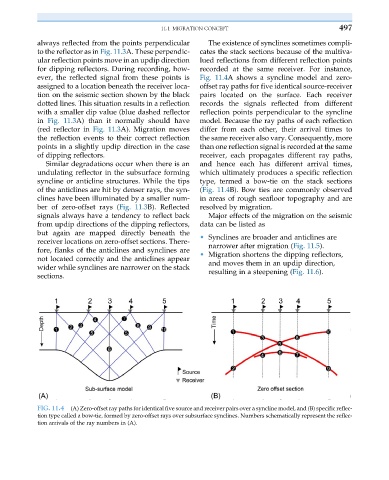Page 506 - Acquisition and Processing of Marine Seismic Data
P. 506
11.1 MIGRATION CONCEPT 497
always reflected from the points perpendicular The existence of synclines sometimes compli-
to the reflector as in Fig. 11.3A. These perpendic- cates the stack sections because of the multiva-
ular reflection points move in an updip direction lued reflections from different reflection points
for dipping reflectors. During recording, how- recorded at the same receiver. For instance,
ever, the reflected signal from these points is Fig. 11.4A shows a syncline model and zero-
assigned to a location beneath the receiver loca- offset ray paths for five identical source-receiver
tion on the seismic section shown by the black pairs located on the surface. Each receiver
dotted lines. This situation results in a reflection records the signals reflected from different
with a smaller dip value (blue dashed reflector reflection points perpendicular to the syncline
in Fig. 11.3A) than it normally should have model. Because the ray paths of each reflection
(red reflector in Fig. 11.3A). Migration moves differ from each other, their arrival times to
the reflection events to their correct reflection the same receiver also vary. Consequently, more
points in a slightly updip direction in the case than one reflection signal is recorded at the same
of dipping reflectors. receiver, each propagates different ray paths,
Similar degradations occur when there is an and hence each has different arrival times,
undulating reflector in the subsurface forming which ultimately produces a specific reflection
syncline or anticline structures. While the tips type, termed a bow-tie on the stack sections
of the anticlines are hit by denser rays, the syn- (Fig. 11.4B). Bow ties are commonly observed
clines have been illuminated by a smaller num- in areas of rough seafloor topography and are
ber of zero-offset rays (Fig. 11.3B). Reflected resolved by migration.
signals always have a tendency to reflect back Major effects of the migration on the seismic
from updip directions of the dipping reflectors, data can be listed as
but again are mapped directly beneath the
receiver locations on zero-offset sections. There- • Synclines are broader and anticlines are
narrower after migration (Fig. 11.5).
fore, flanks of the anticlines and synclines are • Migration shortens the dipping reflectors,
not located correctly and the anticlines appear and moves them in an updip direction,
wider while synclines are narrower on the stack resulting in a steepening (Fig. 11.6).
sections.
FIG. 11.4 (A) Zero-offset ray paths for identical five source and receiver pairs over a syncline model, and (B) specific reflec-
tion type called a bow-tie, formed by zero-offset rays over subsurface synclines. Numbers schematically represent the reflec-
tion arrivals of the ray numbers in (A).

